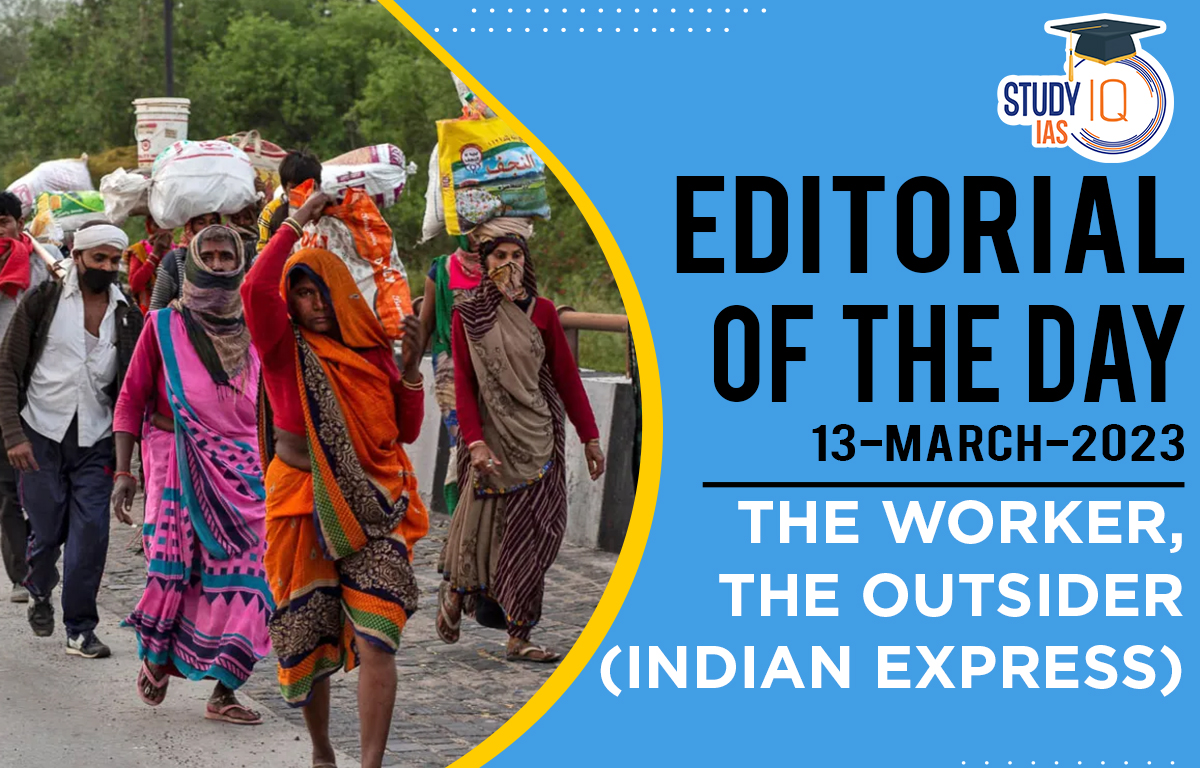Table of Contents
Context: The recent spread of rumors on social media platforms in Tamil Nadu, allegedly detailing assaults on migrant workers, resulted in their non-appearance at work. This absence had a detrimental impact on the industries in the state, causing widespread fear and raising numerous concerns, notably for migrants hailing from northern regions of India.
Background: Facts related to Internal Migration in India
- According to the 2011 census number of internal migrants (both inter-state and within state) in India at 45.36 crore, making up 37% of the country’s population.
- As per Ministry of Housing and Urban Poverty Alleviation 17 districts accounted for the top 25% of India’s total male out-migration. Ten of these districts are in UP, six in Bihar, and one in Odisha.
- As per Migration in India Report, 2021 the all-India migration rate was 28.9% for July 2020-June 2021, with a 26.5 % migration rate in rural areas and 34.9% in urban areas.
- Females recorded a higher share of migration rate of 47.9%; 48% in rural and 47.8% in urban areas. Migration rate for males was 10.7%, with 5.9% in rural and 22.5% in urban areas.
Decoding the Editorial
- This article mentions about the issues and challenges related to the migration in India.
- Migrants are critical contributors to states’ economies at the destination, interstate migrants work while facing insecurities, anxieties and suspicion that stems from their migratory identity. Their victimization is deeply rooted in the politicization of migrants, the stigma, power dynamics of the labour market and scapegoating.
Reasons for the Threat associated with Migrants
- Envious and Hostile native population: Migrants typically assume employment opportunities that are declined by locals and frequently dominate the labor market due to possessing more advanced skillsets than native workers.
- Wage difference: Migrants’ wage rates are frequently lower than the local population, this wage differential means that employers often prefer recruiting migrants.
- Son of soil concept: The persistent apprehension among the local population regarding the potential loss of their cultural and ethnic identity and job prospects often leads to hostility and, in some cases, even physical aggression directed towards migrants.
- Unwanted Migrants: Migrant individuals or groups are often regarded as unwanted or as placing a strain on the host society or community. A case in point is the stigmatization of migrant workers during the COVID-19 pandemic, where government policy failures led to labeling them as “carriers of infection” and “burdens on the system.”
- Structural violence against migrants: Migrants not only suffer from direct physical violence but also face structural violence ingrained in socio-economic and political frameworks. This form of violence can be invisible and takes shape indirectly, with established patterns that make migrants exceedingly vulnerable and systematically marginalized.
- Mental Health issues: Constant fear violence adversely affects the mental health of migrants. In the absence of family, care groups and support mechanisms, the rumours on social media, fear and panic result in enormous stress, anxiety and mental health crises.
How do we protect physically and mentally interstate migrants at their destinations?
- Promoting Unionization: Promoting migrants unionisation, portability of entitlements and ensuring universal social security provisions at the destination state could prove fruitful.
- Strong and committed political will and bureaucratic structure: Stigmatizing migrants and politics of scapegoating are psychological apparatuses used for political benefits.
- National migrants’ policy: To protect interstate migrants from all forms of violence must be reflected in the draft National Migrant Labour policy.
- Awareness of migrant rights: Adequate steps is required to make migrants aware of their legal and civic rights by providing legal-aid and counselling services.
- Migrants Survey: More migration surveys in states like TN to estimate inter-state migrants, like the Kerala model of migration surveys is required. Also, surveys to examine the various contributions made by low-skilled migrants for the improvement of their households, economy and society.
Beyond the Editorial
Steps taken by the Government:
- National Migrant Labour Policy: In 2021, NITI Aayog, along with a working subgroup of officials and members of civil society, has prepared a draft National Migrant Labour policy.
- One Nation One Ration Card (ONORC): The ONORC scheme is being implemented under National Food Security Act (NFSA). ONORC allows all NFSA beneficiaries, particularly migrant beneficiaries, to claim either full or part foodgrains from any Fair Price Shop (FPS) in the country through existing ration card with biometric/Aadhaar authentication in a seamless manner.
- Affordable Rental Housing Complexes (ARHC): It is a Sub-scheme under Pradhan Mantri Awas Yojana- Urban (PMAY-U) to provide affordable rental housing to urban migrants/ poor, close to their workplace.
- e-Shram Portal: It is a portal launched by Ministry of labour and employment to register 38 crore unorganized workers such as construction labourers, migrant workforce, street vendors, and domestic workers, among others.
- Migration is considered a constitutional right in India according to Article 19 of the Constitution and is viewed as a sign of hope and prosperity. However, the recurring attacks on migrants, spread of rumors, and their ongoing precariousness suggest that the nation has overlooked the migrant crisis during the pandemic. Without implementing comprehensive and significant measures, the genuine inclusion of migrants may remain an unattainable aspiration.
Mains Question
- Discuss the changes in the trends of labour migration within and outside India in the last four decades.


 DRDO and Air Force Successfully Test Ind...
DRDO and Air Force Successfully Test Ind...
 IB ACIO Recruitment 2025 Notification Ou...
IB ACIO Recruitment 2025 Notification Ou...





















